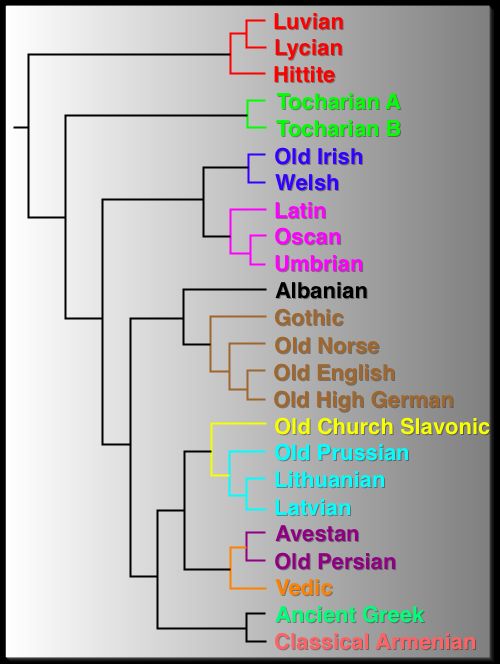

NSF support for this project was provided through grants 0312911 and 0312830.
| 18 | T. Warnow, S.N. Evans, and L. Nakhleh (2023) " Progress on Constructing Phylogenetic Networks for Languages" arXiv v:2306.06298v2 | |
| 17 | F. Barbancon, S.N. Evans, L. Nakhleh, D. Ringe, and T. Warnow (2013) "An experimental study comparing linguistic phylogenetic reconstruction methods." Diachronica 30(2):143-170, and appendix. A preliminary version of this paper appeared in the conference "Languages and Genes", held at UC Santa Barbara, and organized by Bernard Comrie. | |
| 16 | J. Nichols and T. Warnow, "Tutorial on computational linguistic phylogeny." Linguistics and Language Compass, Vol. 2, Issue 5, September 2008, pages 760-820. | |
| 15 | D. Ringe and T. Warnow, "Linguistic history and computational cladistics." In: Origin and Evolution of Languages: Approaches, Models, Paradigms, B. Laks (ed.), Equinox Publishing, March 2008. | |
| 14 | L. Nakhleh, T. Warnow, D. Ringe, and S.N. Evans, "A Comparison of Phylogenetic Reconstruction Methods on an IE Dataset." Transactions of the Philological Society, 3(2): 171-192, 2005. (The full version of the paper includes more details about running the methods, the datasets, etc.) | |
| 13 | L. Nakhleh, D. Ringe, and T. Warnow, "Perfect Phylogenetic Networks: A New Methodology for Reconstructing the Evolutionary History of Natural Languages." LANGUAGE, Journal of the Linguistic Society of America, 81(2):382-420, 2005. | |
| 12 | T. Warnow, S.N. Evans, D. Ringe, and L. Nakhleh, "A stochastic model of language evolution that incorporates homoplasy and borrowing." Phylogenetic Methods and the Prehistory of Languages. MacDonald Institute for Archaeological Research, 2006. | |
| 11 | T. Warnow, S.N. Evans, D. Ringe, and L. Nakhleh, "Stochastic models of language evolution and an application to the Indo-European family of languages." Technical report, Department of Statistics, The University of California, Berkeley, 2004. | |
| 10 | S.N. Evans, Don Ringe, and Tandy Warnow, "Inference of divergence times as a statistical inverse problem." Phylogenetic Methods and the Prehistory of Languages. Cambridge, UK, July 2004. | |
| 9 | S.N. Evans, and Tandy Warnow, "Unidentifiable divergence times in rates-across-sites models." IEEE/ACM Transactions on Computational Biology and Bioinformatics, 1(3): 130-134, 2004. | |
| 8 | E. Erdem, V. Lifschitz, L. Nakhleh, and D. Ringe, "Reconstructing the evolutionary history of Indo-European languages using answer set programming." Proceedings of the 5th International Symposium on Practical Aspects of Declarative Languages (PADL 03), 2003. | |
| 7 | D. Ringe, Tandy Warnow, and A. Taylor, "Indo-European and Computational Cladistics." Transactions of the Philological Society, 100(1):59-129, 2002. | |
| 6 | M. Bonet, C.A. Phillips, T. Warnow, and S. Yooseph, "Constructing evolutionary trees in the presence of polymorphic characters." SIAM J. Computing, 29(1):103-131, 1999. | |
| 5 | D. Ringe, " Tocharian class II presents and subjunctives and the reconstruction of the Proto-Indo-European verb." Tocharian and Indo-European Studies 9:121-142, 2000. | |
| 4 | D. Ringe, T. Warnow, and A. Taylor, "Computational cladistics and the position of Tocharian ." In: The Bronze Age and early Iron Age peoples of eastern Central Asia (1998, ed. Victor Mair; JIES Monograph 26), pp. 391-414. | |
| 3 | T. Warnow, "Mathematical approaches to comparative linguistics." Proceedings of the National Academy of Sciences, Vol. 94, pp. 6585-6590, 1997. | |
| 2 | T. Warnow, D. Ringe, and A. Taylor, "Reconstructing the evolutionary history of natural languages ." Proceedings of the ACM-SIAM Symposium on Discrete Algorithms, 1996, pp. 314-322. | |
| 1 | T. Warnow, D. Ringe, and A. Taylor, "Reconstructing the evolutionary history of natural languages." IRCS Report 95-16. Philadelphia (1995): Institute for Research in Cognitive Science, University of Pennsylvania. Technical report, 18 pp. |